All those coyote sounds you hear at night have an explicit meaning. We humans have been listening to and studying the language of the coyote for many decades. That howling coyote somewhere off in the distance doesn’t realize, yet, but we know what it‘s saying with a great deal of certainty.
Being able to translate coyote sounds doesn’t reduce the mystery or allure of the song dog. Instead, it makes them even more fascinating. Now we can listen in on their conversations. We can eavesdrop on their disputes with each other, hear them call their pups home, and judge the quality of their love songs.
It is one thing to know what howling coyotes are saying, but did you know you can talk back to them? And, with some practice and tools, even get them to come close enough to see the coyote you are talking to? Keep reading; I’ll show you how.
Related: Even when you speak their language, coyotes can never be your pet.
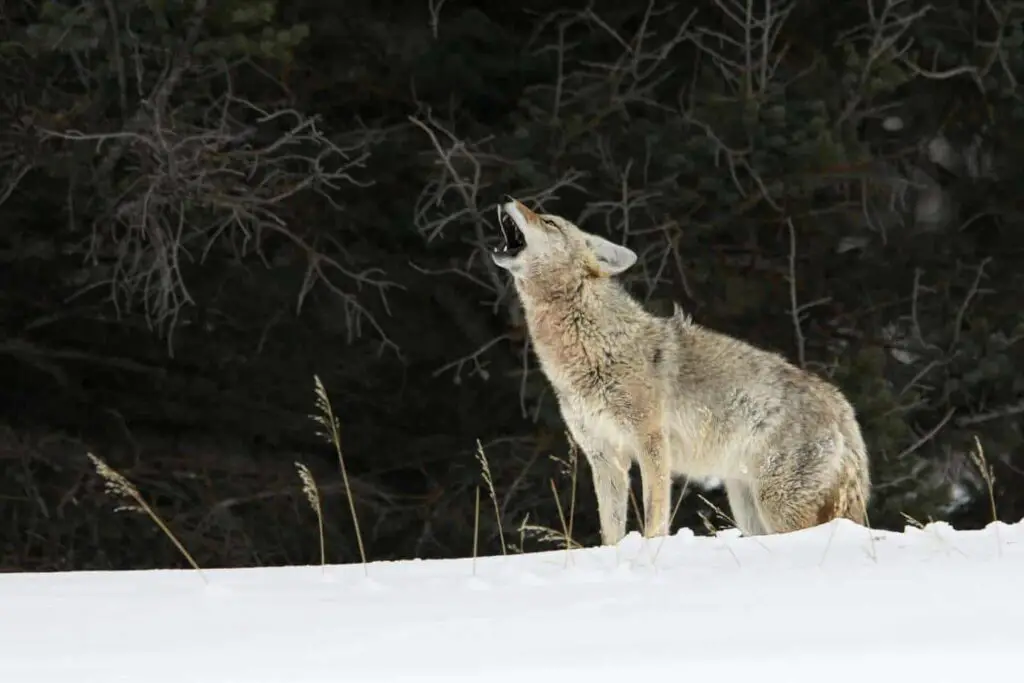
How to translate coyote sounds.
Let’s begin with the basics. Who is making those coyote sounds and what really is a coyote?
A coyote is an undomesticated canine native to North America. Its slender muzzle, bushy, low-hanging tail, and pointed ears resemble a camouflaged German Shepard. Intelligent, highly communicative, and designed to adapt and thrive in almost any environment, a coyote is also surplus-killing predator.
The next thing you need to understand to translate coyote sounds is that you are listening to a family, not a pack. Coyotes do not form packs of genetically different members. This will be critical later when you use your howls to get them to come to see who’s trespassing on their land.
The life of a coyote is the life of a predator, but it is also the life of a family member. Coyotes are dedicated parents and committed mates and live highly structured lives that benefit the whole family.
Most coyote sounds are meant to communicate with each other, warn off unrelated coyotes or other intruders, or alert other family members to potential danger. The rest of a coyote’s vocalizations transmit its emotional states, such as fear, anger, or injury.
Using the coyote calendar to decode a coyote sound.
The coyote calendar is made up of four seasons occurring in this order: mating, denning, pup rearing, and pup dispersal.
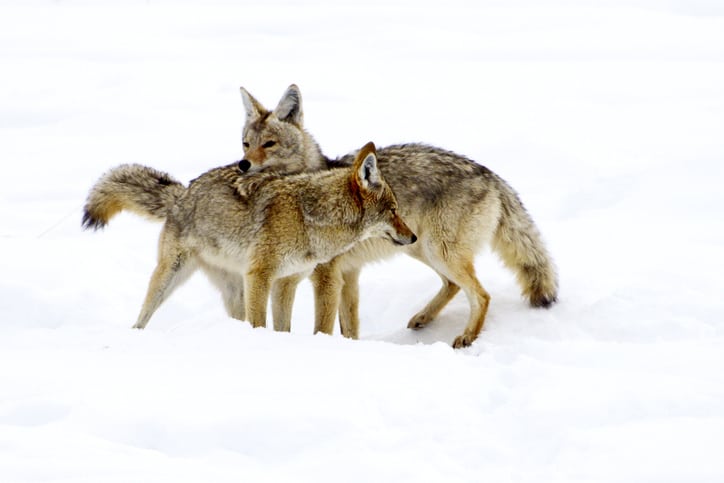
Coyote sounds heard during mating and denning seasons.
Mating Season. Coyote mating season starts with the search for a suitable mate for unattached males and females. Coming on the heels of dispersal season (when first-year pups are forced out of their parent’s territory), this leads to increased travel, more frequent vocalizations, and sightings by humans.
Coyotes mate for life. The mate selection process is meant preserve the genetic line, ensure the two are suited for a lifetime pairing, and will provide a strong parental unit for future litters.
Coyotes choose their mates by first listening and responding to each other’s calls. A male enters a female’s territory and follows her as she hunts. Unless rebuffed, he will increase his interactions with her—laying close by, playing, grooming, guarding, and eventually copulating when she is ready.
The coyote sounds you’ll hear during the mating season? Howls, lots of howls. And estrus chirps, invitation calls, and even the barks of romantic suitors driving off the competition.

Denning Season. After mating, the pair must find a place to bear and raise the future litter. The coyote gestation period (60-63 days) gives them roughly two months to finish the job.
It is the female coyote’s job to do all the digging and alterations. She may dig an entirely new hole, expand an abandoned badger, skunk, or other animal’s den, or use a rock outcropping or hollowed-out tree. The shelter will be located near a water source, have good drainage, and sport a southern-facing opening.
The coyote sounds you’ll hear during the denning season? This season is the period when coyotes are the least vocal. They will issue warning barks to intruders nearing dens, but all coyote sounds will be at lower volumes to reduce the chance of bringing attention to their den’s location.
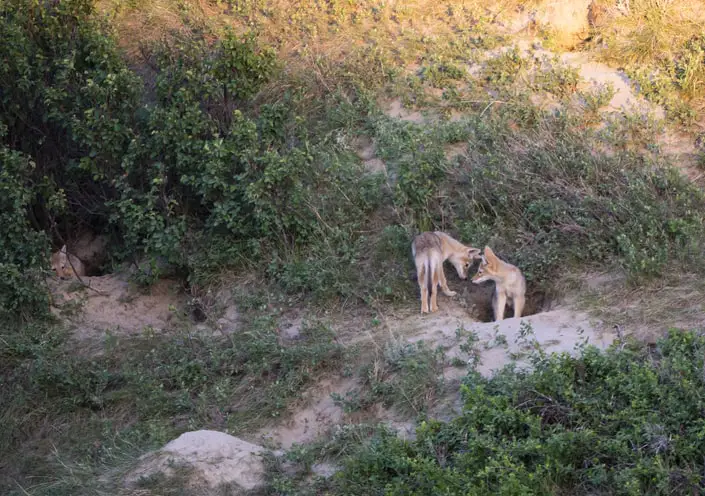
Coyote sounds during pup rearing and dispersal seasons.
Pup rearing season. Within 35 days of birth, a coyote pup starts exploring the world outside its den. To ready it for its new lifestyle, mom and dad will take it to areas like fields with tall grasses and the edges between tree lots and open plains. Here the pups will accompany their parents on short hunts.
For a while, they are always remaining in visual touch. With time, they will start temporarily leaving their parent’s side and testing their hunting skills independently.
The coyote sounds you’ll hear during the pup rearing season? Lots of location calls. Parents and pups will keep announcing their location, and mom will let them know when it is time to return home. There are pups out there getting lost or losing track of time.
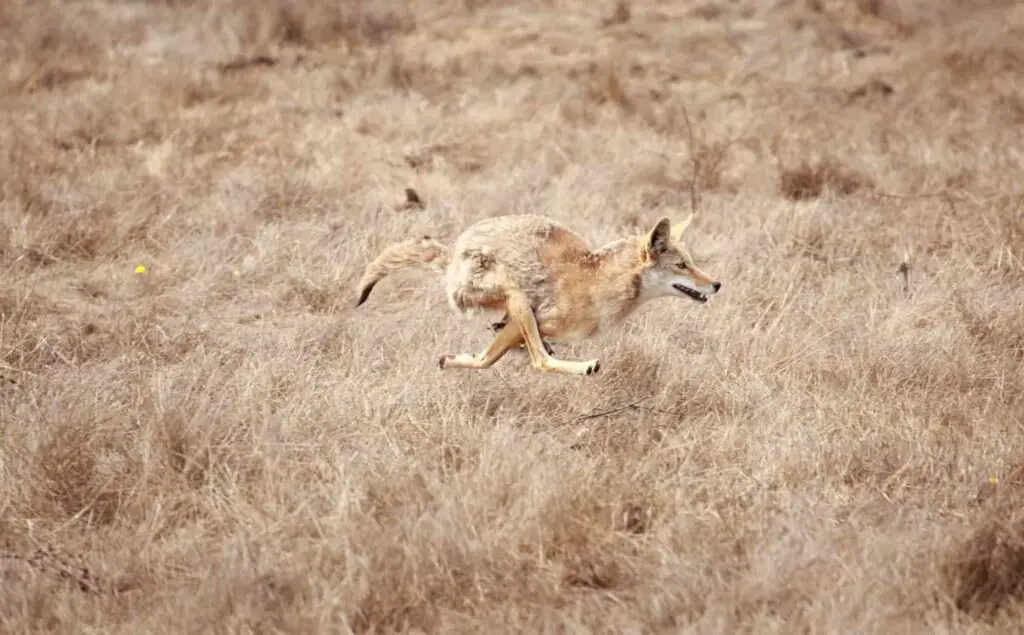
Pup dispersal season. In most of the United States, adult coyote pups are forced out of their family units by September. Far from helpless and trained to hunt and kill by their parents, these young adults will eagerly begin the process of finding territory and mates.
While some females may remain behind, all males are forced to leave to prevent inbreeding. The remaining females will spend the next year acting as helpers to raise the next litter.
Coyote pup dispersal season is noted for one thing in the United States, the sudden appearance of numerous roaming coyotes.
The coyote sounds you’ll hear during the pup rearing season? The woods and fields are full of young, transient coyotes in search of their own territories and mates. These transients do a lot of accidental trespassing on resident coyote lands. Expect a lot of howling and angry barking.
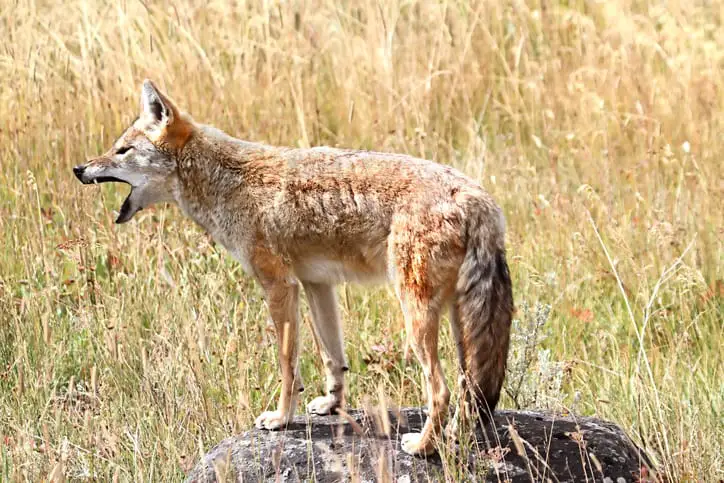
Understanding coyote barks and coyote howls.
Coyote communication is complicated (with the ability to make dozens of sounds) but there are only a few facts you need to understand to interpret most of what you will hear daily.
Most coyote vocalizations consist of two basic vocalizations; howls and barks.
Basic information on coyote howls.
Howls communicate information (who is calling) and location. Howls carry a long way and are undistorted by distance. Humans can hear a howl made by a coyote almost a mile away, but other coyotes can listen to it nearly three miles away.
Humans frequently over-estimate the number of coyotes they hear howling. But, in all likelihood, they are hearing no more than two coyotes.
There are two reasons why just a pair of coyotes howling can sound like a ”pack.”
First, each dog produces several different coyote sounds. As these sounds travel through the air, the environment (trees, bushes, weather) distorts the vocalizations. This creates an auditory allusion the human ear interprets as separate and distinct sounds.
Second, the Beau Geste effect achieves the same result on other non-family coyotes. Potential trespassers (like transient coyotes or other family units) also significantly overestimate the size of the group vocalizing. Sounding like your group is huge in numbers is the safest way to avoid conflict.
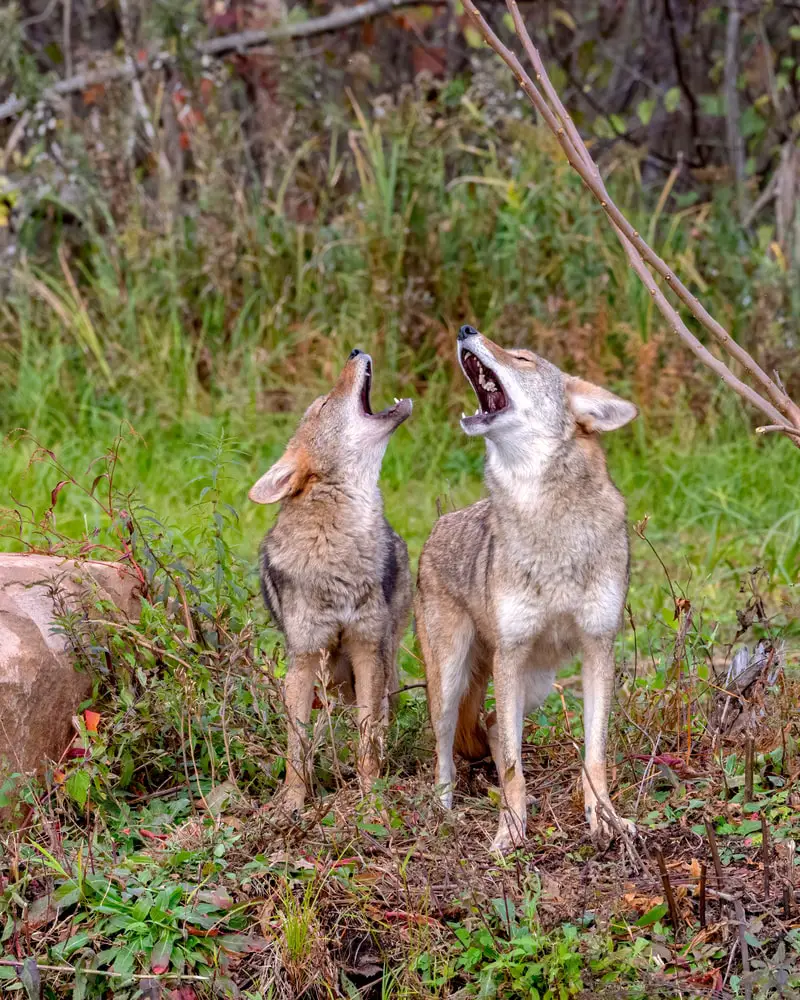
The types of coyote howls.
The Lone Howl. A single coyote makes the lone howl and usually begins with a series of barks whose tone and frequency help identify the howler to other coyotes.
Group Howls. Two or more coyotes make group howls. These howl communicate their position to other family members to reassemble, announce their territory, and keep other coyotes away.
Woo-oo-wow. This sound helped coin the term “Song Dog” for the coyote. This howl is used during family greetings and communicates a great deal of emotion with its fluency modulations and amplitude.
The types of coyote barks, woofs, growls and huffs.
Barks are higher frequency calls, degrade rapidly, and communicate who is calling and exactly how far away they are from the hearer. Barks are used to warn of trouble or danger. A coyote hearing a bark knows a family member needs help and precisely which direction they are in and the travel distance to reach them.
As a human, you can safely enjoy the howling and most other coyote sounds. Only the barks, if loud, could apply to you. A loud barking coyote is defending something from which it cannot move away. Back off, and that coyote will leave you alone.
Barks. Barks are alerts to other coyotes about potential threats. Barks are the equivalent of the human, “Come check this out.”
Bark-howls. Bark-howls signal a clear and present danger, which is already a threat to the family or me.
Growls. Growls mean a threat is too close. Coyotes use this to drive that threat away. Female coyotes near a den will use a low growl to lure an intruder away from their den.
Huffs. A sharp exhalation of air. I’ve only heard it at bait piles. When a coyote makes the huff sound, the other coyotes usually retreat a few yards.
Woofs. Woofs are precursors to bark if the threat level increases. Similar to that of a domesticated dog, it is made when something startles or puzzles a coyote.
Related: How to deal with suburban coyotes.
Related: Is that coyote poop in your yard?
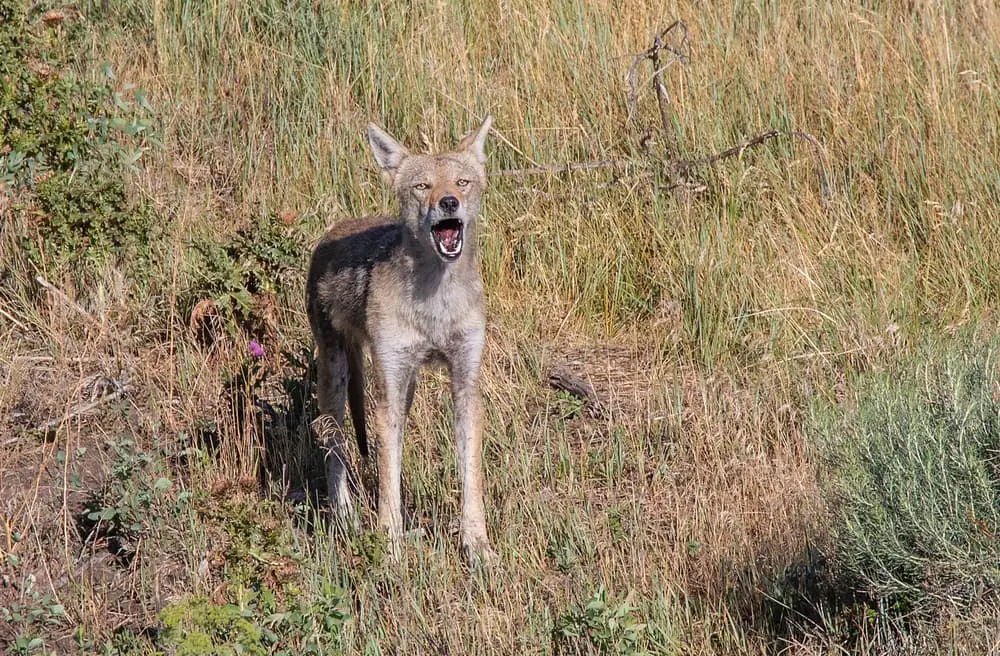
Other coyote sounds: Estrus chirps, whines, and yelps.
Estrus chirps. Sound made by female coyotes who are ready to mate. Although not used as much or as well know, this sound works well to call in coyotes during the winter (breeding) season.
Whine. The sound a coyote make to indicate submission to and more dominate coyote.
Yelp. A sound of pain and extreme surprise.
How to used a coyote sound to bring a coyote in closer.
If you want to try and use coyote sounds to lure coyotes in close enough to be seen, you have two choices: an electronic or closed caller.
An electronic caller is expensive but will work right out of the box. It has all the coyote sounds you’ll need, plus a host of prey calls from animals coyotes eat. A closed reed caller is inexpensive but takes some practice.
Closed reed callers primarily make prey in distress sounds.
The other problem with a mouth-caller is convincing yourself you can make it work—even if the first few tries end up sounding atrocious. I felt this way myself.
There is something about closed-reed coyote calls that excites predators and gets their attention. Often, despite the abilities of the caller and the uncertain sound we make. My miserable efforts, however, produced a result often seen in the coyote-hunting world.
How easy is it to use a closed reed coyote call?
We asked Brian Rush of Rush Custom Callers that question. Few men know more about producing realistic coyote sounds. He spent less than five minutes demonstrating one of his rabbit squealers and even included a pro tip for use on stubborn, hung-up coyotes.
Trust me; Brian just showed you everything you need to know to use a closed-reed coyote call in the field. Bookmark, tag, or do whatever you must to rewatch this video until you can produce the same sounds he does.
Now you can listen, understand, and even make a few coyote sounds.
Go out, especially at night, and when you hear those coyote howls, maybe just cup your hands together and howl back.
Who knows what that coyote might have to say.

